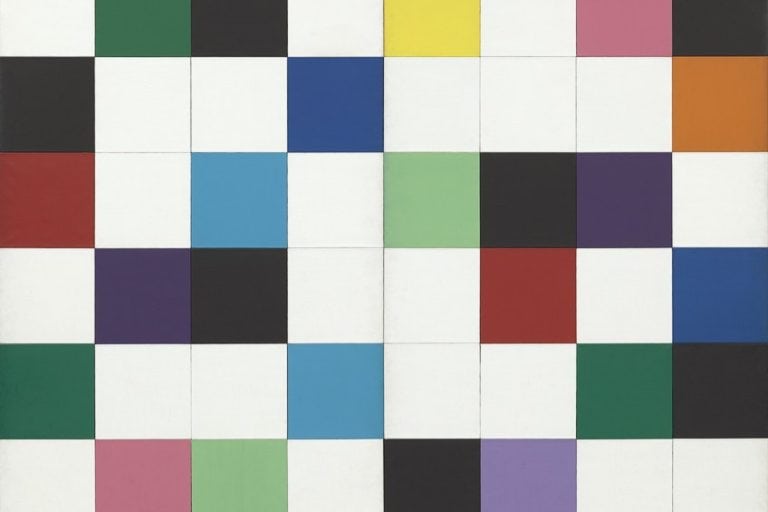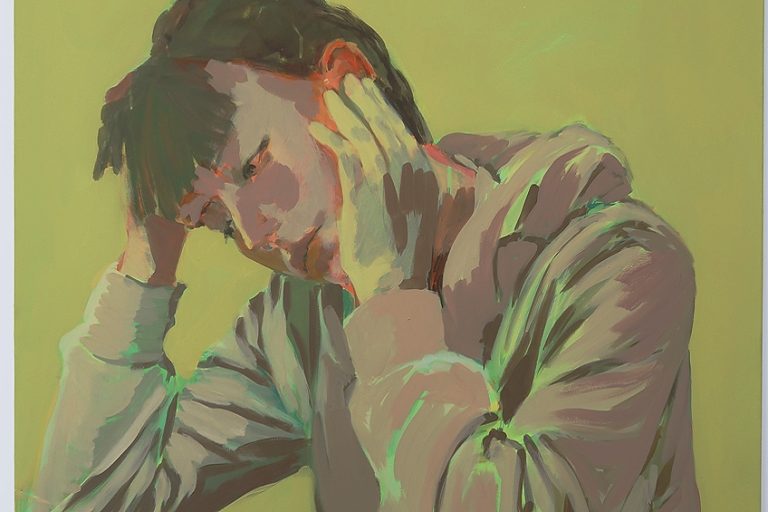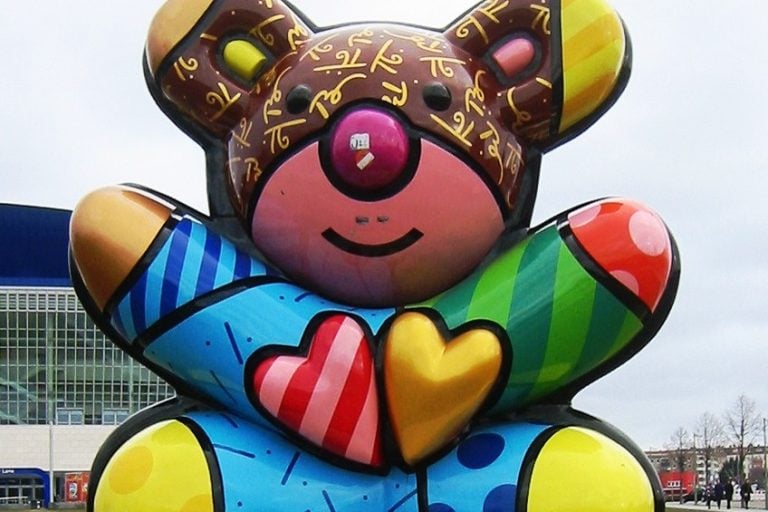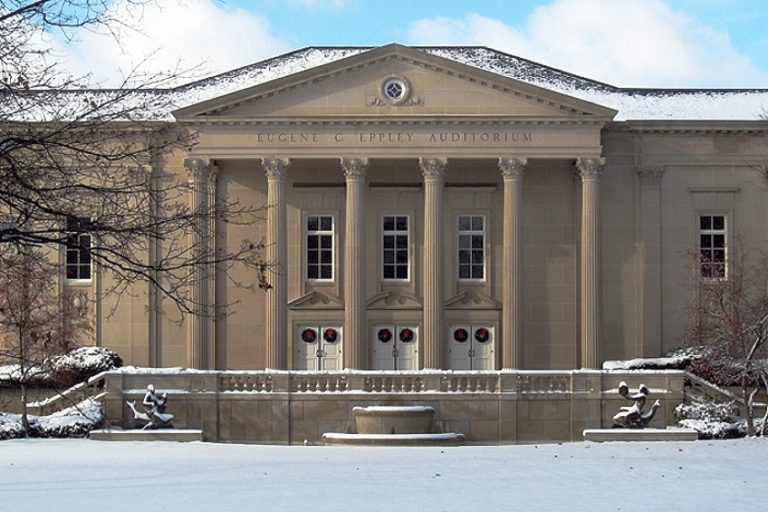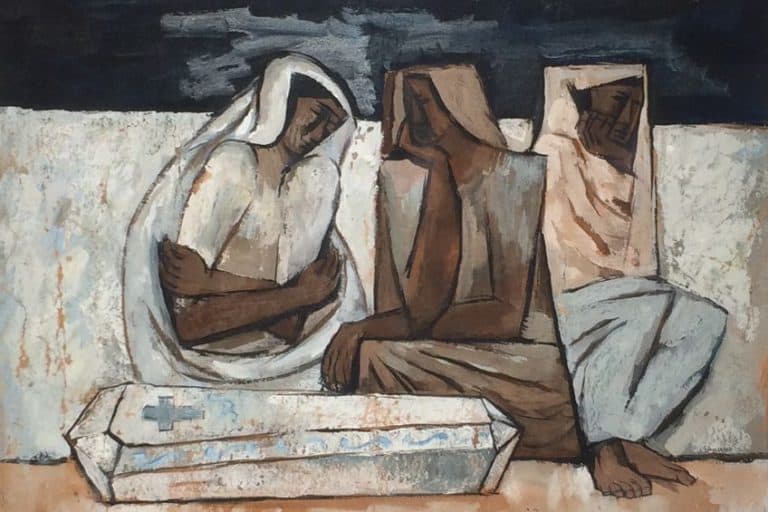Fernando Botero – A Look at Fernando Botero Paintings
Renowned for his distinctive style characterized by voluptuous figures and exaggerated proportions, Fernando Botero has left an indelible mark on the art world through his mesmerizing paintings and sculptures. In this article, we delve into the life and works of the Colombian painter, exploring the allure of his renowned Fernando Botero paintings and sculptures, and answering questions like “where is Fernando Botero from?”, “what makes Fernando Botero’s paintings so special?”, and “in what context did this Colombian painter develop his unique style?”.
Fernando Botero: Artist Abstract
| Date of Birth | 19 April 1932 |
| Place of Birth | Medellín, Colombia |
| Nationality | Colombian |
| Style | Boterismo |
| Period | Contemporary art and Modern art |
Fernando Botero, born in Medellín, Colombia, in 1932, embarked on a creative journey from an early age that would transform the art world. His artistic inclinations were evident even in his childhood, as he began sketching and experimenting with various mediums. Botero’s passion for art led him to pursue formal training at the Fine Arts Academy in Medellín, where he honed his skills and developed a keen eye for composition and technique.
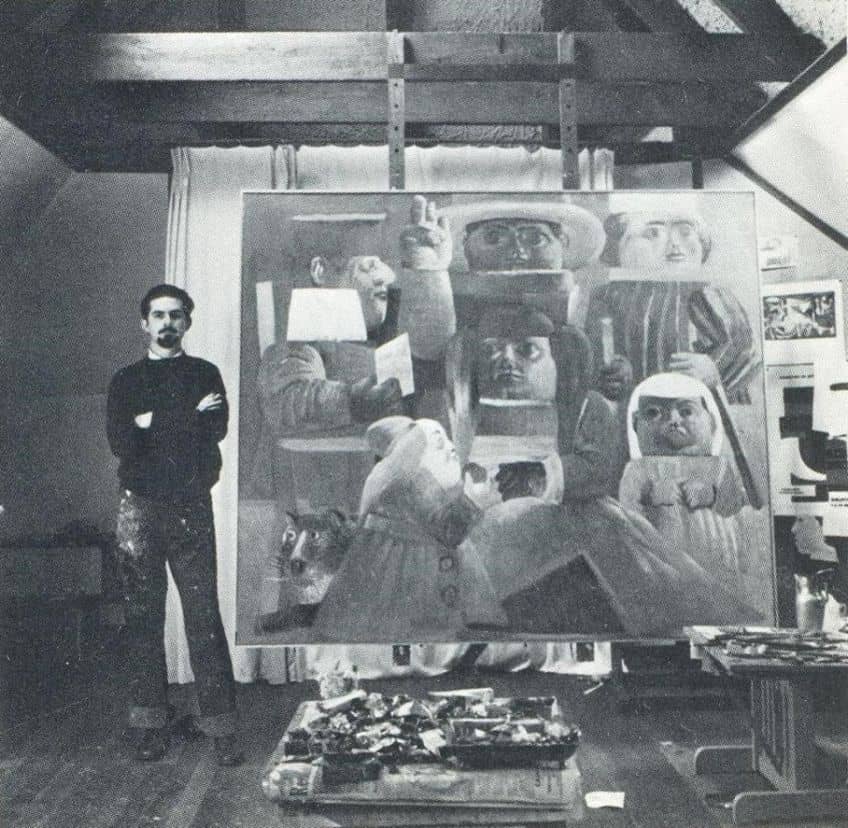
Early Years
In his early artworks, Botero displayed a profound understanding of classical art, drawing inspiration from the works of Italian Renaissance painters. This influence can be observed in his meticulous attention to detail, harmonious use of color, and mastery of light and shadow. However, Botero soon embarked on a unique artistic path, deviating from conventional norms and embracing a distinctive style that would become his artistic signature.
Gaining Recognition
Botero’s career flourished as he gained recognition for his singular approach to portraying human and animal figures. His paintings and sculptures, characterized by their robust forms and exaggerated proportions, challenged traditional notions of beauty and captivated viewers with their unmistakable allure.
Through his masterful technique, Botero infused his subjects with a sense of volume, sensuality, and vitality, breathing life into each canvas or sculpture.
Career Milestones
Throughout his illustrious career, Botero achieved numerous milestones and left an indelible mark on the art world. His iconic paintings, such as Mona Lisa, Age Twelve (1959), and The Presidential Family (1967), have become emblematic of his unique style and have been widely celebrated for their boldness and depth of expression. These works, among many others, showcase Botero’s exceptional ability to convey emotion and social commentary through his distinctive visual language.
Fernando Botero’s Influence on Art History
Beyond his individual achievements, Botero’s influence on art history cannot be overstated. His audacious departure from established norms challenged the boundaries of artistic representation, opening new avenues for expression and inspiring generations of artists. Botero’s legacy extends beyond his native Colombia, as his works have garnered international acclaim, earning him a prominent place in the annals of contemporary art.
Fernando Botero’s artistic vision continues to captivate audiences worldwide, inviting viewers to see the world through a lens of vibrant vitality and a celebration of human and animal forms. His enduring legacy stands as a testament to the power of art to transcend boundaries, provoke thought, and evoke profound emotional responses, making him one of the most influential figures in the history of art.
Fernando Botero’s Paintings in Context
Fernando Botero not only created visually captivating artworks but also used his brush to reflect and comment on the socio-political context of his time. Botero’s paintings stand as a testament to his acute awareness of power dynamics, inequality, and the human condition, providing a scathing critique of societal issues.
Botero grew up in a Colombia marked by political turbulence and social disparities. These experiences undoubtedly shaped his artistic vision and motivated him to confront the prevailing realities through his work. Throughout his career, Botero was unafraid to delve into controversial subjects, challenging the status quo and shedding light on the darker aspects of society.
One recurring theme in Botero’s paintings is the portrayal of power and its abuses.
In his series of political paintings, such as The Death of Pablo Escobar (1999), he offers a biting critique of political corruption and the entwined relationship between power, wealth, and violence. By depicting political figures and notorious criminals, Botero exposed moral bankruptcy and the consequences of unchecked authority. In addition to political commentary, Botero also explored the effects of societal inequalities on the human condition. Through his portrayals of everyday people, often with exaggerated forms, he shed light on the struggles faced by the marginalized and the downtrodden. His work, The Street (2000) serves as a poignant reminder of the social divisions that persist, where poverty and hardship coexist with opulence and excess.
Botero’s art goes beyond mere critique; it serves as a vehicle for social dialogue and reflection. By presenting these societal issues with his distinct style, characterized by rounded figures and a vibrant color palette, he draws viewers into his world, compelling them to confront uncomfortable truths. Botero’s paintings demand attention and invite viewers to question the status quo, ultimately aiming to ignite positive change. The socio-political context in which Botero created his paintings is crucial to understanding and appreciating his artistic contributions fully. By delving into the complexities of power, inequality, and the human condition,
Botero challenges viewers to examine their own roles within society and to reflect on the broader implications of social and political systems.
Today, Fernando Botero’s paintings continue to resonate as powerful statements and reminders of the need for social awareness and change. His art remains a testament to the transformative power of artistic expression, shedding light on the issues that define our world and inspiring viewers to engage with the socio-political landscape in meaningful ways. Through his enduring works, Botero’s socio-political canvas stands as an enduring call for justice, empathy, and a more equitable society.
Fernando Botero Sculptures
Within the realm of art, few styles are as instantly recognizable as Boterismo, the unique artistic approach developed by Colombian artist Fernando Botero. Defined by its exaggerated volume, rounded forms, and playful sensibility, Boterismo encompasses a distinct set of formal art elements that make Botero’s sculptures truly remarkable.
In this section of the article, we delve into the captivating world of Boterismo, unpacking the key elements that constitute this iconic style by doing a visual and conceptual analysis of one of Botero’s famous sculptures.
From the robust and voluptuous figures to the meticulous attention to texture and the infusion of wit and satire, we explore how these formal art elements intertwine to create Botero’s extraordinary sculptures, leaving a lasting impression on viewers worldwide.
Woman with Fruit (1998) Sculpture by Fernando Botero: A Harmonious Balance of Form and Symbolism
| Title | Woman with Fruit |
| Date | 1998 |
| Medium | Bronze |
| Dimensions (cm) | N/A |
| Style | Boterismo |
| Location | Heumarkt, Bamberg, Germany |
Situated in the picturesque city of Bamberg on the Heumarkt, the sculpture Woman with Fruit (1998) by Fernando Botero commands attention with its voluminous figure and serene presence. The visual analysis reveals Botero’s signature style, as the plump, rounded form of the woman takes center stage. The exaggerated proportions and voluptuousness emphasize her physicality, creating a captivating visual impact. The meticulous attention to detail is evident in the intricate surface textures, accentuating the folds of her clothing and the smoothness of the fruit she holds. The harmonious balance between the smooth contours and the textured elements adds a dynamic quality to the sculpture.
Conceptually, Woman with Fruit carries a deeper symbolic meaning. The woman, with her ample figure, represents abundance and fertility. The presence of fruit in her hands further emphasizes these concepts, symbolizing nourishment, growth, and the richness of life. Botero’s choice to depict the woman with a serene expression evokes a sense of tranquility and contentment, suggesting a harmonious relationship with nature and the abundance it provides.
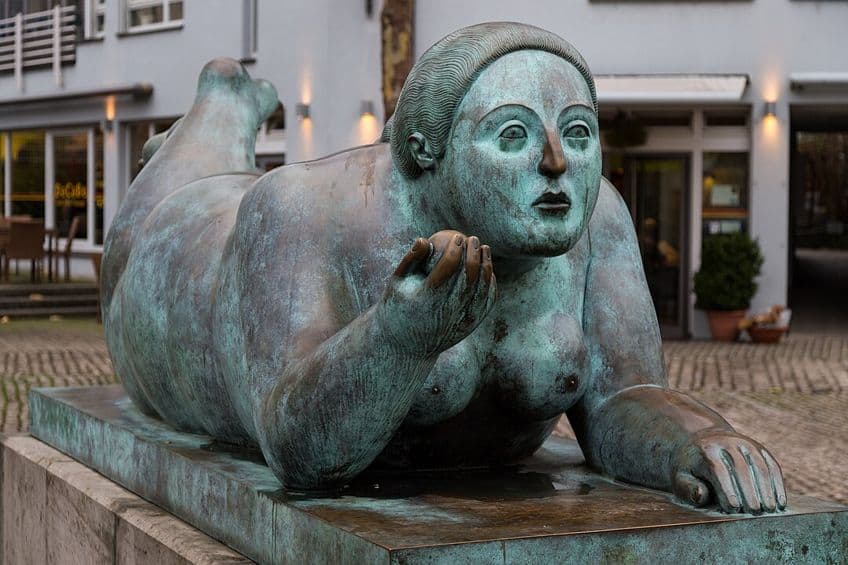
Moreover, the sculpture invites contemplation on themes of beauty and body image. By presenting a figure that defies societal norms of thinness, Botero challenges conventional standards of attractiveness and prompts viewers to question preconceived notions. The woman’s self-assured stance and unapologetic representation exude confidence and assert the importance of embracing diverse forms of beauty.
Woman with Fruit exemplifies Botero’s ability to merge form and concept seamlessly. Through his distinctive style, the sculpture engages viewers with its visual allure, while the symbolic undertones invite deeper contemplation on themes of abundance, beauty, and self-acceptance.
As this captivating artwork graces the Heumarkt in Bamberg, it not only enhances the city’s aesthetic appeal but also serves as a thought-provoking testament to the power of art to inspire introspection and challenge societal norms.
Fernando Botero Paintings
Fernando Botero’s paintings possess a distinctiveness that sets them apart and makes them truly special. One of the key factors is Botero’s unique style, characterized by his portrayal of figures with exaggerated proportions and voluptuous forms. This distinctive approach challenges conventional notions of beauty and invites viewers to see the world through a fresh lens.
Botero’s mastery lies not only in his ability to capture the physical essence of his subjects but also in his remarkable command of color, light, and composition. His vibrant and harmonious use of color infuses his paintings with a captivating energy, while his meticulous attention to detail brings each scene to life.
Furthermore, Botero’s paintings often carry underlying social and political messages, providing a commentary on power dynamics, inequality, and the human condition. This fusion of technical skill, unique style, and thought-provoking content elevates Botero’s paintings to a realm of artistic significance, making them truly special and leaving a lasting impact on viewers. Let us look at one of the Colombian painter’s well-known artworks.
Death of Pablo Escobar (1999) by Fernando Botero: A Profound Visual and Conceptual Exploration
| Title | Death of Pablo Escobar |
| Date | 1999 |
| Medium | Oil on canvas |
| Dimensions (cm) | N/A |
| Style | Naïve art |
| Location | N/A |
In Death of Pablo Escobar, Fernando Botero takes us on a profound journey of visual and conceptual exploration. The visual analysis reveals Botero’s distinct style, characterized by his portrayal of robust figures and exaggerated forms. In this painting, the central focus lies on the body of the notorious Colombian drug lord, Pablo Escobar, being executed by police. Botero’s deliberate choice to depict Escobar with enlarged proportions creates a heightened sense of presence and power, despite his demise. The meticulously rendered details, from the folds of clothing to the facial expression, capture the gravity of the scene.
Conceptually, the painting delves into themes of power, downfall, and the consequences of unchecked authority.
By depicting the death of Escobar, Botero offers a critical commentary on the destructive nature of a life consumed by greed and criminality. The monumental size of Escobar’s body highlights the magnitude of his impact and the magnitude of his fall. In this portrayal, Botero prompts viewers to confront the darker aspects of human nature and reflect upon the complex dynamics of power and corruption.
Furthermore, the composition and use of color enhance the painting’s conceptual depth. The surrounding environment, rendered in somber tones, evokes a sense of unease and foreboding. The stark contrast between the dark background and the illuminated figure of Escobar creates visual tension, underscoring the significance and impact of his demise.
Death of Pablo Escobar by Fernando Botero stands as a poignant visual and conceptual statement. Through his mastery of form, composition, and symbolism, Botero invites viewers to contemplate the consequences of power, the fragility of life, and the intricate web of choices that shape our world. This thought-provoking artwork not only captures a significant historical event but also serves as a reminder of the complexities of human existence and the inherent transience of power.
In conclusion, Fernando Botero stands as a towering figure in the annals of art history. His unique style has left an indelible mark on the art world. Through his paintings and sculptures, Botero challenges conventional notions of beauty, provokes thought on social and political issues, and invites viewers to see the world through a fresh lens. His artistic contributions go beyond mere aesthetics, as he delves into the complexities of power dynamics, inequality, and the human condition. Botero’s ability to merge technical skill, distinct style, and thought-provoking content has earned him a prominent place in the art historical canon.
Take a look at our Fernando Botero paintings webstory here!
Frequently Asked Questions
Where Is Fernando Botero From?
Fernando Botero hails from Medellín, Colombia, a city that played a significant role in shaping his artistic sensibilities and worldview. Growing up in a country marked by socio-political turbulence and stark inequalities, Botero’s background had a profound impact on his art. His experiences in Colombia provided him with a firsthand understanding of power dynamics, social disparities, and the struggles faced by the marginalized. These realities influenced his artistic vision, leading him to create works that not only captivate viewers with their distinctive style, but also serve as a powerful commentary on societal issues. Botero’s Colombian roots infused his art with a deep sense of social consciousness, encouraging viewers to confront uncomfortable truths and challenging them to reflect on their own roles within a complex world.
What Are the Characteristics of Fernando Botero’s Sculptures?
Fernando Botero’s sculptures possess distinct artistic characteristics that set them apart and make them instantly recognizable. One defining feature is the exaggerated volume and rounded forms that define his figures. Botero’s sculptures often depict human and animal subjects with plump, robust bodies, emphasizing their physical presence and commanding attention. Another characteristic is the meticulous attention to detail and texture. Botero’s sculptures showcase intricate surface treatments, such as richly textured skin or intricate patterns on clothing, enhancing the visual interest and tactile quality of the artwork.
What Makes Fernando Botero’s Paintings So Special?
Fernando Botero’s paintings are truly unique and remarkable. His portrayal of figures with exaggerated proportions and voluptuous forms challenges conventional beauty standards and offers viewers a fresh perspective. Botero’s mastery extends beyond capturing the physical essence, as he demonstrates a remarkable command of color, light, and composition. The vibrant colors and meticulous attention to detail infuse his paintings with energy and bring them to life. Additionally, Botero’s works often conveys social and political messages, addressing power dynamics, inequality, and the human condition. This fusion of technical skill, distinctive style, and thought-provoking content elevates Botero’s paintings to a realm of artistic significance, leaving a lasting impact on viewers.
Nicolene Burger is a South African multi-media artist, working primarily in oil paint and performance art. She received her BA (Visual Arts) from Stellenbosch University in 2017. In 2018, Burger showed in Masan, South Korea as part of the Rhizome Artist Residency. She was selected to take part in the 2019 ICA Live Art Workshop, receiving training from art experts all around the world. In 2019 Burger opened her first solo exhibition of paintings titled, Painted Mantras, at GUS Gallery and facilitated a group collaboration project titled, Take Flight, selected to be part of Infecting the City Live Art Festival. At the moment, Nicolene is completing a practice-based master’s degree in Theatre and Performance at the University of Cape Town.
In 2020, Nicolene created a series of ZOOM performances with Lumkile Mzayiya called, Evoked?. These performances led her to create exclusive performances from her home in 2021 to accommodate the mid-pandemic audience. She also started focusing more on the sustainability of creative practices in the last 3 years and now offers creative coaching sessions to artists of all kinds. By sharing what she has learned from a 10-year practice, Burger hopes to relay more directly the sense of vulnerability with which she makes art and the core belief to her practice: Art is an immensely important and powerful bridge of communication that can offer understanding, healing and connection.
Nicolene writes our blog posts on art history with an emphasis on renowned artists and contemporary art. She also writes in the field of art industry. Her extensive artistic background and her studies in Fine and Studio Arts contribute to her expertise in the field.
Learn more about Nicolene Burger and the Art in Context Team.
Cite this Article
Nicolene, Burger, “Fernando Botero – A Look at Fernando Botero Paintings.” Art in Context. July 19, 2023. URL: https://artincontext.org/fernando-botero/
Burger, N. (2023, 19 July). Fernando Botero – A Look at Fernando Botero Paintings. Art in Context. https://artincontext.org/fernando-botero/
Burger, Nicolene. “Fernando Botero – A Look at Fernando Botero Paintings.” Art in Context, July 19, 2023. https://artincontext.org/fernando-botero/.



